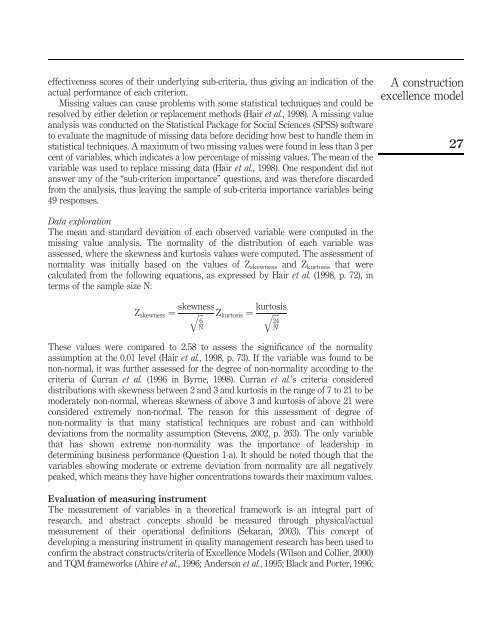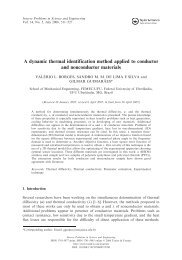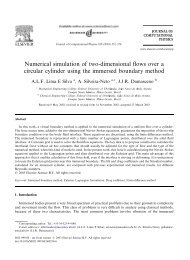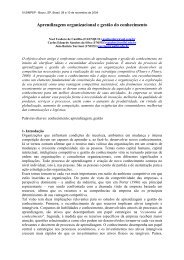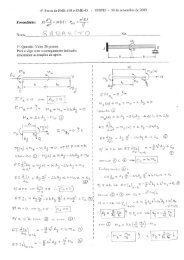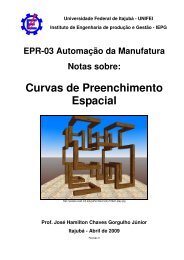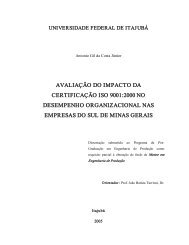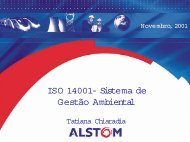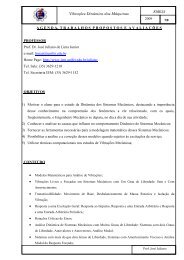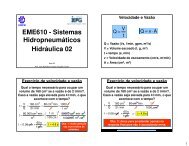Evaluation and analysis of criteria and sub-criteria of a ... - Emerald
Evaluation and analysis of criteria and sub-criteria of a ... - Emerald
Evaluation and analysis of criteria and sub-criteria of a ... - Emerald
Create successful ePaper yourself
Turn your PDF publications into a flip-book with our unique Google optimized e-Paper software.
effectiveness scores <strong>of</strong> their underlying <strong>sub</strong>-<strong>criteria</strong>, thus giving an indication <strong>of</strong> theactual performance <strong>of</strong> each criterion.Missing values can cause problems with some statistical techniques <strong>and</strong> could beresolved by either deletion or replacement methods (Hair et al., 1998). A missing value<strong>analysis</strong> was conducted on the Statistical Package for Social Sciences (SPSS) s<strong>of</strong>twareto evaluate the magnitude <strong>of</strong> missing data before deciding how best to h<strong>and</strong>le them instatistical techniques. A maximum <strong>of</strong> two missing values were found in less than 3 percent <strong>of</strong> variables, which indicates a low percentage <strong>of</strong> missing values. The mean <strong>of</strong> thevariable was used to replace missing data (Hair et al., 1998). One respondent did notanswer any <strong>of</strong> the “<strong>sub</strong>-criterion importance” questions, <strong>and</strong> was therefore discardedfrom the <strong>analysis</strong>, thus leaving the sample <strong>of</strong> <strong>sub</strong>-<strong>criteria</strong> importance variables being49 responses.A constructionexcellence model27Data explorationThe mean <strong>and</strong> st<strong>and</strong>ard deviation <strong>of</strong> each observed variable were computed in themissing value <strong>analysis</strong>. The normality <strong>of</strong> the distribution <strong>of</strong> each variable wasassessed, where the skewness <strong>and</strong> kurtosis values were computed. The assessment <strong>of</strong>normality was initially based on the values <strong>of</strong> Z skewness <strong>and</strong> Z kurtosis that werecalculated from the following equations, as expressed by Hair et al. (1998, p. 72), interms <strong>of</strong> the sample size N:Z skewness ¼ skewness qffiffiZ kurtosis ¼ kurtosis qffiffiffi6NThese values were compared to 2.58 to assess the significance <strong>of</strong> the normalityassumption at the 0.01 level (Hair et al., 1998, p. 73). If the variable was found to benon-normal, it was further assessed for the degree <strong>of</strong> non-normality according to the<strong>criteria</strong> <strong>of</strong> Curran et al. (1996 in Byrne, 1998). Curran et al.’s <strong>criteria</strong> considereddistributions with skewness between 2 <strong>and</strong> 3 <strong>and</strong> kurtosis in the range <strong>of</strong> 7 to 21 to bemoderately non-normal, whereas skewness <strong>of</strong> above 3 <strong>and</strong> kurtosis <strong>of</strong> above 21 wereconsidered extremely non-normal. The reason for this assessment <strong>of</strong> degree <strong>of</strong>non-normality is that many statistical techniques are robust <strong>and</strong> can withholddeviations from the normality assumption (Stevens, 2002, p. 263). The only variablethat has shown extreme non-normality was the importance <strong>of</strong> leadership indetermining business performance (Question 1-a). It should be noted though that thevariables showing moderate or extreme deviation from normality are all negativelypeaked, which means they have higher concentrations towards their maximum values.<strong>Evaluation</strong> <strong>of</strong> measuring instrumentThe measurement <strong>of</strong> variables in a theoretical framework is an integral part <strong>of</strong>research, <strong>and</strong> abstract concepts should be measured through physical/actualmeasurement <strong>of</strong> their operational definitions (Sekaran, 2003). This concept <strong>of</strong>developing a measuring instrument in quality management research has been used toconfirm the abstract constructs/<strong>criteria</strong> <strong>of</strong> Excellence Models (Wilson <strong>and</strong> Collier, 2000)<strong>and</strong> TQM frameworks (Ahire et al., 1996; Anderson et al., 1995; Black <strong>and</strong> Porter, 1996;24N


